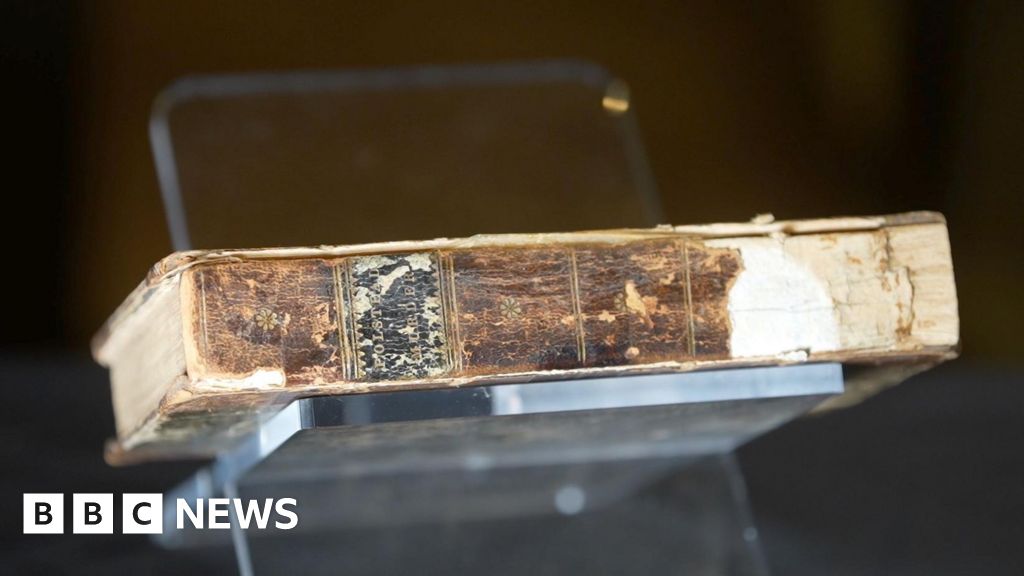The Gruesome Legacy of William Corder: A Murderer Whose Skin Binds a Book

In a chilling revelation that has captured public attention, a book housed at the Moyses Hall Museum in Bury St Edmunds, Suffolk, has been discovered to be bound in the skin of a notorious murderer from the 19th century. This grim historical artifact is linked to William Corder, who was hanged for the infamous Red Barn Murder in 1828a case that shocked Georgian Britain and continues to fascinate historians and the public alike.
Curators at the museum have recently uncovered that the cover of this particular book, which had been collecting dust on a bookshelf in an office, is made from the skin of Corder, a man whose heinous crime has left an indelible mark on British history. The book was donated to the museum decades ago by a family closely associated with the surgeon who anatomized Corder's body after his execution, adding another layer of intrigue to this already macabre tale. With its newfound notoriety, the book is now on display for the public to view, inviting a closer examination of the dark history it represents.
William Corder was born into a family of tenant farmers in the quaint village of Polstead, situated between Ipswich and Sudbury. At the age of 22, he was known to have a reputation as a charming ladies' man and struck up a relationship with 24-year-old Maria Marten. Maria, who lived a modest life with her father, stepmother, sister, and young son, may have viewed her relationship with Corder as her ticket to a better life. In an attempt to escape their mundane reality, the couple devised a plan to elope, with Corder instructing Maria to meet him at the Red Barn located on the family farm. However, this planned rendezvous would mark the last time anyone would see Maria alive.
Following their meeting at the Red Barn, Corder went on to deceive the Marten family, claiming that he and Maria had eloped to the Isle of Wight. In reality, he had murdered her, shooting her in the neck, and buried her remains at the very location where they were supposed to start a new life together. Almost a year later, Maria's father, armed with a "mole spud" spade, unearthed her body after a vivid dream led him to suspect that she was dead and buried at the Red Barn. This gruesome discovery ignited a frantic manhunt for Corder, who, in a twist of fate, attempted to escape his loneliness by placing an advertisement in a newspaper seeking a new wife.
Corder's capture was swift. The authorities were alerted to his whereabouts, yet he continued to deny any involvement in Maria's disappearance, even as evidence mounted against him. He stood trial in Bury St Edmunds, facing multiple counts of murder, each charge based on different theories regarding Marias death. In a desperate bid for absolution, Corder even accused the deceased Maria of taking her own life. Ultimately, the jury found him guilty after a two-day trial, and in a moment of finality, he confessed that he had indeed shot Maria during a dispute. On August 11, 1828, a crowd estimated between 7,000 and 10,000 people gathered to witness his public execution, transforming what should have been a somber event into a grotesque spectacle. Rumor has it that due to the overwhelming number of spectators, the authorities had to breach a wall of the prison to accommodate the hanging.
The aftermath of the Red Barn Murder turned Polstead into a morbid tourist attraction, with people flocking to see the site and even taking pieces of Maria's gravestone as souvenirs. William Corder's story has since infiltrated popular culture, inspiring numerous books, plays, and songs. Today, his death mask is preserved at Moyses Hall Museum and Norwich Castle, where it continues to draw curious visitors, while a skeletal remains used for medical education at West Suffolk Hospital have long since deteriorated. In an unsettling twist, two books covered in Corder's skin and even a piece of his scalp have become part of the museum's collection, serving as haunting reminders of a dark chapter in history.
The first of the two books is dedicated to the trial, penned by journalist Jay Curtis, and features an inscription from the surgeon George Creed, revealing that Creed himself tanned Corder's skin to bind this book in 1838. The second book is believed to be an identical edition, entitled 'Polstead William Corder', and was also donated by a family with ties to Creed. The museum is planning a future exhibition aimed at shedding light on the often-overlooked stories of female victims in Suffolk's history, including the tragic tale of Maria Marten.
Moyses Hall Museum reports that around 80% of its visitors express a keen interest in learning more about the Red Barn Murder. Heritage assistant Abbie Smith notes that the gruesome and sensational nature of the story is what continues to captivate audiences today. As the museum prepares to delve deeper into this complex narrative, it also seeks to address the portrayal of Corder and how history has oftentimes misrepresented victims like Maria. In a world where the macabre often draws a crowd, the Red Barn Murder remains a chilling reminder of the past, entwining crime, love, and tragedy into a single tale of human folly.













